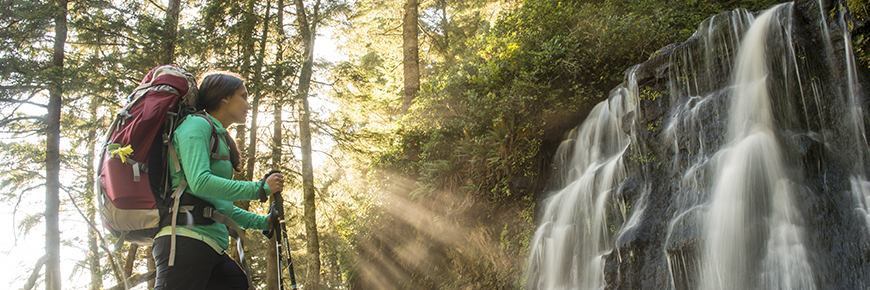
Rainforest in Canada! Where?
Pacific Rim National Park Reserve
- The rainforest recipe
- What does it look like?
- Rainforests around the world
- It's in the leaves
- Stuff that is alive, was alive, and will be alive
- Protected, but not protected
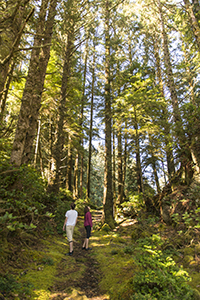
The temperate rainforest of North America are dominated by conifers
The south western coast of Canada drips with water and abounds with plant life; truly a rainforest. It stretches:
- West to the Pacific Ocean;
- North towards the boreal forest, arctic tundra and wetlands;
- South to the dry forests and steppes of California;
- East to the crest of the Coast Mountains;
- and up mountain slopes to alpine tundra and glaciers.
Both Pacific Rim and Gwaii Haanas National Park Reserves of Canada strive to protect examples of Canada's temperate rainforest.No matter where you are in the park, if your feet aren't in salt water, then you are probably in the rainforest. Whether you are pitching your tent in a campground, hiking a trail, or driving to one of the communities outside the park, you are in the rainforest.
The rainforest recipe
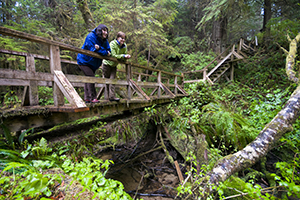 Approximately 3 meters of rain fall on this area each year.
Approximately 3 meters of rain fall on this area each year.- Rain, and lots of it (or other precipitation, i.e. snow, drizzle, mist, fog....). The area must receive a minimum of 250cm of moisture (100 inches) per year. Our moist maritime climate keeps the landscape wet most of the year, giving us an annual precipitation of about 300cm (120 inches).
- Forest (Without trees we might have grasslands, but it wouldn't be rainforest).
What does it look like?
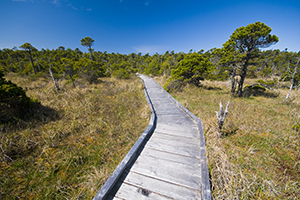 Early morning fog floats above the bog
Early morning fog floats above the bogImagine: An open forest of trees so twisted and stunted they look like broccoli, reaching up from a mass of thick, wet moss, drenched in rain that collects in pools.
A forest of trees so huge, tall and ancient we all look like little children beside them. A world of vivid green moss, arching ferns, and a mass of plants so thick it's impossible to see the soil beneath it. Both images are part of the rainforest. What the rainforest looks like depends on the soil, topography, proximity to the ocean, soil moisture and the length of time it has been left undisturbed.
Temperate rainforests progress through a number of stages: mature, old growth and ancient old growth.
Characteristics that you are likely to notice in old growth forests are:
- trees that range in age from small seedlings just starting out, to very old and grand trees that have lived many hundreds of years;
- many canopy layers (each tree's upper levels of vegetation);large standing snags (broken trees, usually dead);
- large logs on the forest floor and in streams;
- an abundance of plants growing on other plants (epiphytes and parasites);
- a dense understory of shrubbery;
- and an abundance of green in more shades than you can count, no matter what the time of year.
Rainforests around the world
Sometimes you hear the words "tropical" and "temperate" associated with rainforests. The difference is in the location. If the rainforest is close to the equator, it is considered tropical. If the rainforest is farther away from the equator (between the Arctic Circle and the Tropic of Cancer or the Antarctic Circle and the Tropic of Capricorn) then the forest is considered to temperate.
Since Canada's rainforest falls between the Arctic Circle and the Tropic of Cancer, our forests are temperate. Other countries that have temperate rainforests include Chile, New Zealand and Norway. All temperate rainforests share similar characteristics, but different plants and animals populate each.
It's in the leaves
Many of the world's temperate rainforests of the world are a mix of both deciduous (broad-leafed) and coniferous (scaly or needle-leafed) trees. The dominance of conifers in our rainforest is one characteristic that distinguishes our temperate rainforests.Regardless of what they look like, rainforests all over the world are extremely important to the earth's health in contributing to the diversity of life.
Stuff that is alive, was alive, and will be alive.
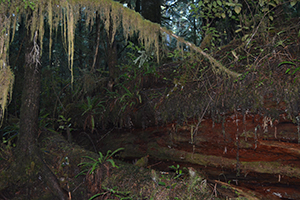 "Nurse logs" provide valuable habitat for young seedlings.
"Nurse logs" provide valuable habitat for young seedlings.The sheer size and age these trees can attain, in combination with all the other plants and animals found here, make this one of the highest biomass producing communities on earth.
One interesting thing about all this biomass is that there isn't a lot of diversity (or different kinds) of life. In other words, there are large amounts of the same few species. It doesn't take long to learn some of the key species that you will see over and over and over again.
Protected, but not protected
 A new generation grows amongst the moss.
A new generation grows amongst the moss.Establishment of this national park in 1970 stopped some activities within the park. Commercial logging and the development of private and commercial residences are no longer permitted.
Still, other activities that stress the rainforest continue. Park visitation, for example, requires roads, trails, buildings, and campsites, compete for valuable space in the crowded rainforest.
When we add up all these impacts, they are significant. For example, the park has a visitation of nearly 600,000 people annually. Unless each of us shares in taking care of the park (also known as stewardship), how can there be an ecologically healthy park to visit?
This is why Parks Canada provides simple guidelines for visitors to follow:
 Tread lightly!
Tread lightly!- Stay on the trail: trails are planned and designed to let visitors see the environment but protect it from our trampling feet. Boardwalks protect tree roots, allowing people to get close without hurting the plant life;
- Keep pets on a leash and children close to the group: predators such as black bears and cougars call the rainforest their home. Make noise to warn them that you are in the area. Keep your group together and back out of the area if you see a predator. For more information see You are in Bear Country .
Related links
- Date modified :